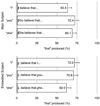Saying "that" in dialogue: The influence of accessibility and social factors on syntactic production
- PMID: 23087498
- PMCID: PMC3475512
- DOI: 10.1080/01690965.2010.537482
Saying "that" in dialogue: The influence of accessibility and social factors on syntactic production
Abstract
Previous evidence suggests that when speakers produce sentences from memory or as picture descriptions, their choices of sentence structure are influenced by how easy it is to retrieve sentence material (accessibility). Three experiments assessed whether this pattern holds in naturalistic, interactive dialogue. Pairs of speakers took turns asking each other questions, the responses to which allowed mention of an optional "that" before either repeated (accessible) or unrepeated (inaccessible) material. Speakers' "that" mention was not sensitive to the repetition (accessibility) manipulation. Instead, "that" mention was sensitive to social factors: Speakers said "that" more when adopting another's perspective rather than one's own, and tended to say "that" more when attributing emotions to oneself rather than another. A fourth experiment confirmed that in a memory task, the original pattern is observed. These results suggest that "that" mention is sensitive to the cognitive forces that operate within a production task; in dialogue settings, social factors were especially influential.
Figures





Similar articles
-
Representation of others' synchronous and asynchronous sentences interferes with sentence production.Q J Exp Psychol (Hove). 2023 Jan;76(1):180-195. doi: 10.1177/17470218221080766. Epub 2022 Mar 9. Q J Exp Psychol (Hove). 2023. PMID: 35102784
-
Saying what's on your mind: working memory effects on sentence production.J Exp Psychol Learn Mem Cogn. 2011 Nov;37(6):1503-14. doi: 10.1037/a0024350. Epub 2011 Jul 18. J Exp Psychol Learn Mem Cogn. 2011. PMID: 21767058 Free PMC article.
-
Aligning sentence structures in dialogue: evidence from aphasia.Lang Cogn Neurosci. 2019;34(6):720-735. doi: 10.1080/23273798.2019.1578890. Epub 2019 Feb 12. Lang Cogn Neurosci. 2019. PMID: 31815155 Free PMC article.
-
Proactive interference effects on sentence production.Psychon Bull Rev. 2002 Dec;9(4):795-800. doi: 10.3758/bf03196337. Psychon Bull Rev. 2002. PMID: 12613685 Free PMC article.
-
Effect of ambiguity and lexical availability on syntactic and lexical production.Cogn Psychol. 2000 Jun;40(4):296-340. doi: 10.1006/cogp.1999.0730. Cogn Psychol. 2000. PMID: 10888342
Cited by
-
(Not) Hearing Optional Subjects: The Effects of Pragmatic Usage Preferences.J Mem Lang. 2012 Jul 1;67(1):211-223. doi: 10.1016/j.jml.2012.02.011. Epub 2012 Mar 20. J Mem Lang. 2012. PMID: 22754087 Free PMC article. No abstract available.
-
Do verb bias effects on sentence production reflect sensitivity to comprehension or production factors?Q J Exp Psychol (Hove). 2013 Aug;66(8):1548-71. doi: 10.1080/17470218.2012.753924. Epub 2013 Jan 4. Q J Exp Psychol (Hove). 2013. PMID: 23286581 Free PMC article.
-
What Does That Mean? Complementizers and Epistemic Authority.Open Mind (Camb). 2024 Mar 26;8:366-394. doi: 10.1162/opmi_a_00135. eCollection 2024. Open Mind (Camb). 2024. PMID: 38571531 Free PMC article.
References
-
- Bock JK. The effect of a pragmatic presupposition on syntactic structure in question answering. Journal of Verbal Learning and Verbal Behavior. 1977;16:723–734.
-
- Bock JK. Toward a cognitive psychology of syntax: Information processing contributions to sentence formulation. Psychological Review. 1982;89:1–47.
-
- Bock JK. Meaning, sound, and syntax: Lexical priming in sentence production. Journal of Experimental Psychology: Learning, Memory, and Cognition. 1986;12:575–586.
-
- Bock JK. An effect of the accessibility of word forms on sentence structures. Journal of Memory and Language. 1987;26:119–137.
-
- Bock JK, Irwin DE. Syntactic effects of information availability in sentence production. Journal of Verbal Learning and Verbal Behavior. 1980;19:467–484.
Grants and funding
LinkOut - more resources
Full Text Sources
